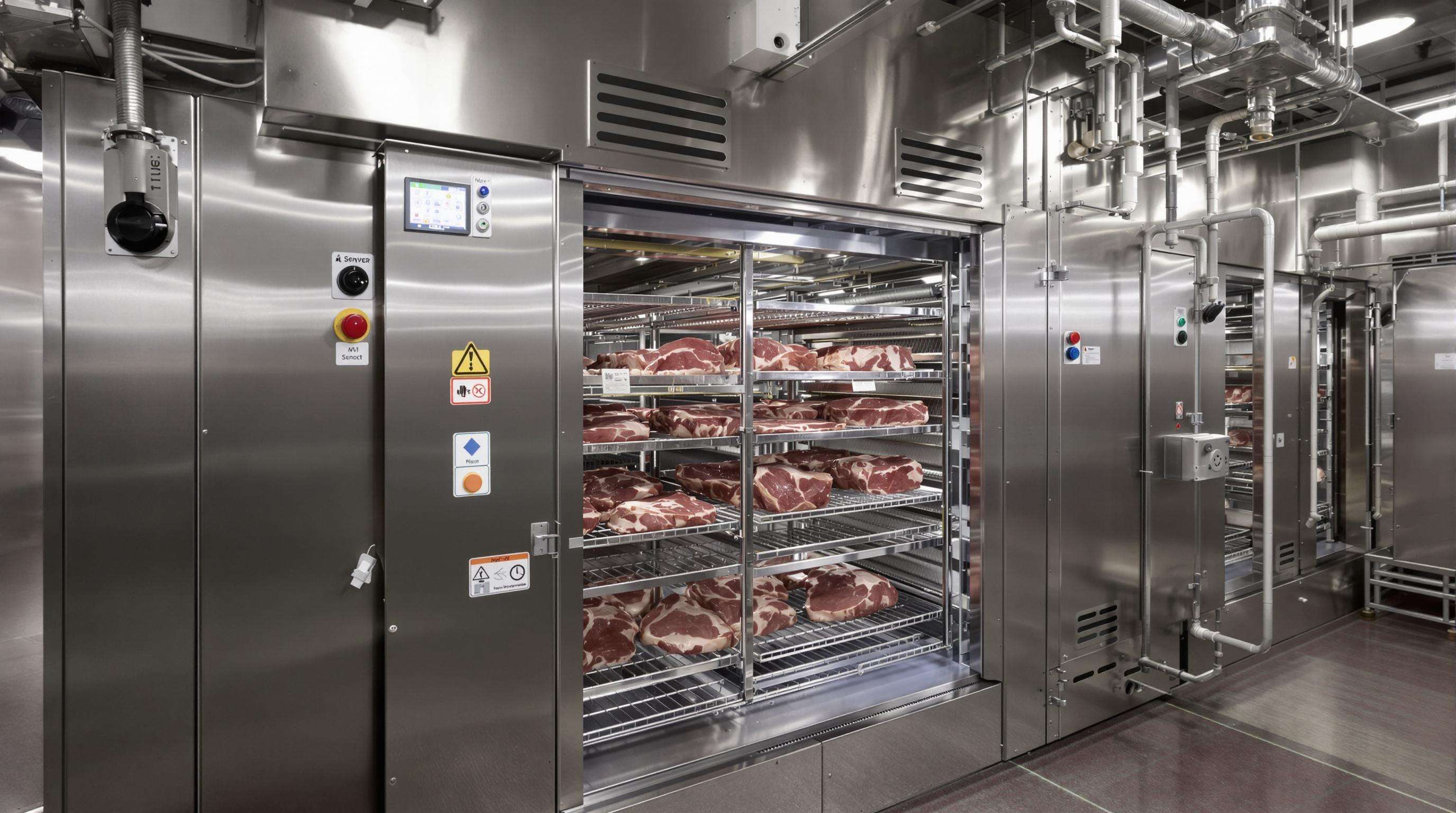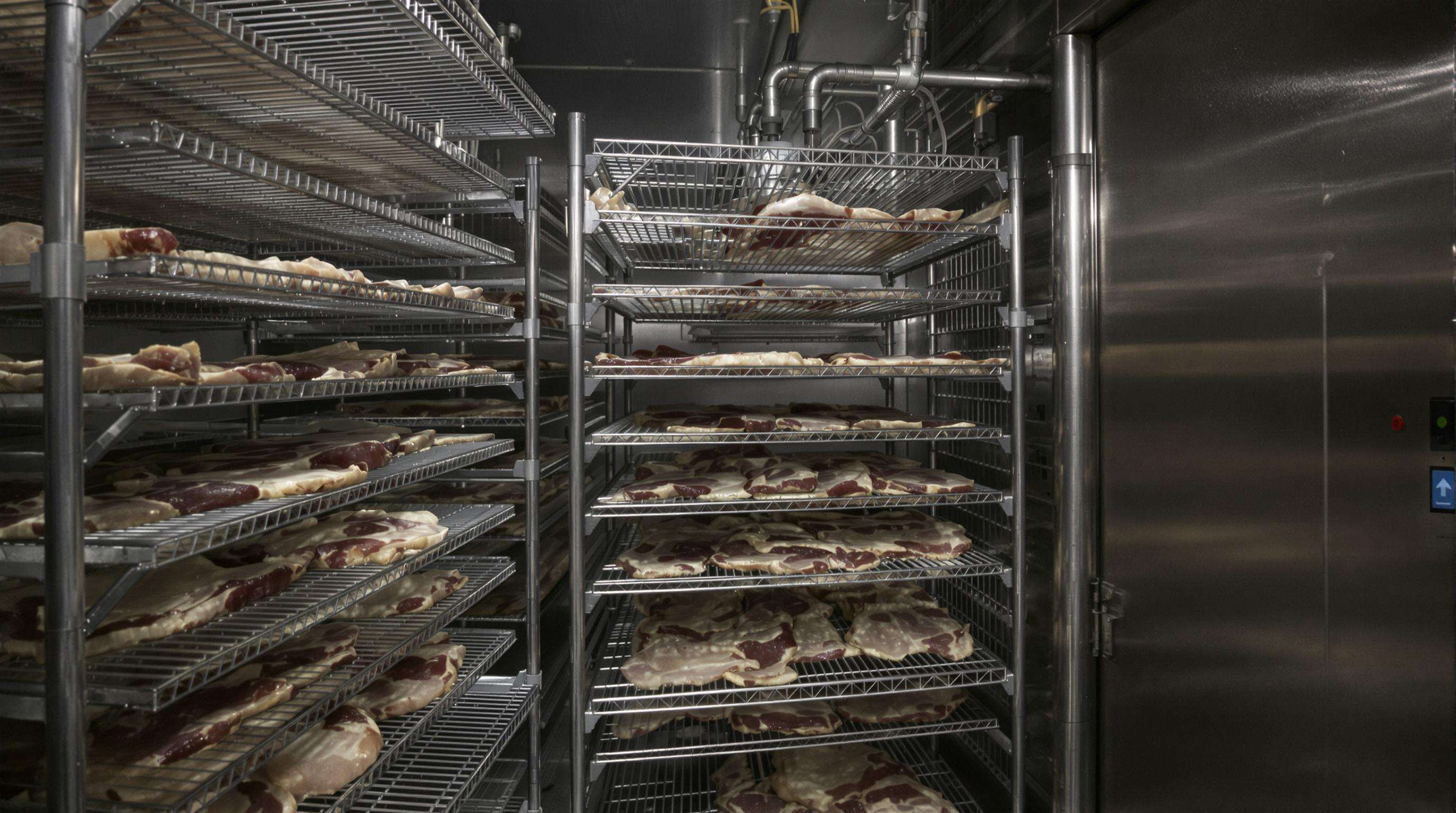Fundamentals of Drying Techniques in Meat Dryer Machines
The Role of Drying Techniques in Meat Preservation
Memeat dryer machineat dryer machines work wonders against bacteria because they cut down moisture levels between 15 and 25 percent, making it really hard for dangerous bugs like Salmonella and E. coli to survive. What makes these dryers so great? They don't need any chemicals added during processing, yet still keep most nutrients intact. Think about this: food poisoning costs the world economy around 740 billion dollars each year according to research from Ponemon in their 2023 report. Pretty staggering number when you consider how much money gets wasted on sick people and contaminated products. The best models on the market today actually mix traditional hot air drying with vacuum technology that pulls out extra water without damaging what's left behind. These advanced systems manage to hold onto nearly all those important proteins and amino acids we want in our food.
How Controlled Environments Enhance Food Safety and Quality
Controlling temperatures between 40 and 70 degrees Celsius along with keeping humidity levels around 10 to 30 percent relative humidity makes a big difference in commercial meat drying operations. These conditions help stop harmful microbes from growing while still preserving the desired texture of the product. Meat processors who have switched to automated systems equipped with moisture sensors report about a 60% drop in contamination cases when compared to old fashioned manual methods according to recent findings from the Food Protection Alliance. What makes these systems so effective? They ensure even airflow throughout the chamber which prevents those annoying wet spots that can develop during processing. The equipment also adjusts ventilation automatically depending on how thick the cuts are, and keeps detailed records of all the important monitoring points throughout the drying cycle.
Scientific Principles Behind Meat Drying and Shelf-Life Extension
When food loses moisture, it drops the water activity (Aw) level below 0.85 which happens to be where most bacteria stop reproducing. Combine this with proper control of the Maillard reaction during processing and meats can last on store shelves for nearly a year and a half without needing refrigeration. Premium freeze dryers maintain an impressive 94% of the original vitamin B12 found in fresh meat. Compare that to traditional sun drying methods which only keep about 76% according to research published in Food Science Journal last year. The numbers check out against what the USDA recommends too their standards call for keeping Aw under 0.90 to ensure safety when selling shelf stable meat products across state lines.
Precision Temperature Control in Meat Dryer Machine Operations

Maintaining Texture and Flavor Through Accurate Thermal Regulation
Getting the temperature right matters a lot when running meat dryer machines. Keeping things around ±1.5°F (about ±0.8°C) helps keep those important proteins called myoglobins intact in cured meats, something that makes all the difference in how they look and feel after processing. These days most good quality dryers come equipped with smart sensors that constantly tweak where the heat goes throughout the chamber. This prevents spots from getting too hot, which can mess up the proteins in the meat. Industry research from last year showed something pretty interesting too – if temperatures drift more than 2°F (roughly 1.1°C), fermented sausages start losing their distinctive flavors at rates between 18% and 22%. That kind of drop really impacts product quality down the line.
Real-Time Monitoring and Automated Temperature Adjustments
The latest generation of meat drying equipment comes equipped with smart sensors that check conditions roughly every 45 seconds, cutting down on temperature fluctuations by around 90% when compared to older manual methods. This kind of constant oversight helps keep things within safe limits for food handling requirements and also saves quite a bit on power costs over time. We've seen this work well in practice tests too where the machines automatically tweak settings when there's a sudden jump in humidity levels, keeping the drying process going strong without affecting how good the finished product tastes or looks.
Impact of Temperature Fluctuations on Final Product Quality
Just 30 minutes of uncontrolled temperature variance (±5°F/2.8°C) increases case hardening by 34%, leading to moisture pockets that accelerate spoilage. Modern systems counteract this with dual-zone thermal regulation, using independent heating elements to maintain cavity equilibrium. This approach has reduced product rejection rates by up to 27% in large-scale charcuterie production.
Humidity Management and Drying Efficiency in Meat Dryer Machines

Preventing Microbial Growth Through Optimal Humidity Control
Maintaining 50–60% relative humidity (RH) in meat dryer machines creates an inhospitable environment for pathogens like Salmonella and Listeria. Humidity fluctuations exceeding ±5% RH increase microbial survival rates by 18–22% (2023 Food Safety Report). Closed-loop control systems achieve ±1.5% RH accuracy, minimizing overdrying risks and ensuring compliance with USDA safety standards.
Balancing Moisture Removal with Meat Texture Integrity
Effective drying requires phased humidity reduction:
- Phase 1: 65–70% RH to prevent case hardening
-
Phase 2: Gradual decrease to 45% RH to facilitate collagen breakdown
Aggressive drying below 40% RH increases chewiness by 31% in jerky, while under-drying above 55% RH compromises shelf life.
Smart Sensors and Automated Feedback for Consistent Drying
Industrial meat dryer machines now use hygrostats with machine learning algorithms that respond 12 times faster than manual systems. Real-time moisture sensors detect ±0.3% deviations and trigger corrections within 8 seconds—improving response time by 90% over timer-based methods. This automation ensures batch consistency despite 25–30% variations in raw meat moisture content.
Hygiene and Automation in Advanced Meat Dryer Machines
Enhancing Sanitation with Advanced Technology in Meat Drying
Modern meat dryer machines integrate UV-C light sterilization and Clean-In-Place (CIP) systems, eliminating 99.7% of surface pathogens (2024 food safety study). These automated processes run during idle periods, ensuring continuous hygiene without manual intervention.
Sterilization Cycles and Air Filtration for Food Safety
Advanced models combine sterilization cycles with H13 HEPA filtration, achieving bioburden reduction rates four times higher than conventional methods. This dual system prevents cross-contamination while maintaining optimal airflow for efficient drying.
Automation vs. Traditional Cleaning: Effectiveness in Commercial Settings
Automated cleaning protocols reduce bacterial contamination incidents by 82% compared to manual scrubbing in commercial settings. They also cut sanitation labor costs by 45% while consistently meeting FDA-grade cleanliness standards.
Energy Efficiency and Sustainability in Meat Dryer Machine Design
Evaluating Energy Performance Across Commercial Meat Dryer Models
When looking at how modern meat dryers perform, most folks check their energy usage in terms of kilowatt hours per kilogram of dried meat. Research indicates that when we shorten the drying time to around 24 hours, these machines hit about 38.7 to 43.1 percent efficiency, which beats the longer cycles by roughly four to six percentage points. The newer models come equipped with features that save energy too. Things like adjustable speed fans and better insulated chambers cut down on basic power needs anywhere from 12 to 18 percent over older equipment. For processors concerned about running costs, this kind of improvement makes all the difference in daily operations.
Sustainable Features That Reduce Power Consumption
Thermal recovery systems in leading meat dryer machines redirect waste heat to pre-warm incoming air, lowering energy use by up to 20% in high-capacity models. Solar-compatible designs and phase-change materials (PCMs) are emerging innovations that stabilize internal temperatures without continuous compressor operation.
Industry Trends: The Shift Toward Eco-Friendly Drying Techniques for Meat
More than two thirds of commercial meat processing plants are going with ENERGY STAR certified dryers these days because customers want their products to leave a smaller carbon footprint. Some companies have started using smart humidity sensors powered by artificial intelligence along with maintenance systems that predict when parts need replacing. These technologies cut down on wasted energy during early tests by around twenty two percent according to preliminary results. Looking ahead, most experts believe that nearly nine out of ten new meat drying machines will somehow include renewable energy sources by the middle of next decade.
FAQ Section
What are the benefits of using a meat dryer machine?
Meat dryer machines reduce moisture levels in meat, preventing the growth of bacteria like Salmonella and E. coli without using chemicals. They help retain nutrients and ensure food safety.
How do controlled environments improve food safety in meat drying?
Controlled temperature and humidity levels prevent harmful microbes from growing, maintaining the desired texture and quality of meat. Automated systems enhance these controls, significantly reducing contamination cases.
What role does temperature regulation play in meat drying?
Precise temperature control ensures the integrity of proteins like myoglobin, maintaining the texture and flavor of processed meats. It also prevents spoilage and product rejection.
How does humidity management affect meat drying efficiency?
Proper humidity control prevents microbial growth and ensures the right texture by maintaining specific RH levels, which are adjusted during different drying phases.
Are modern meat dryer machines energy efficient?
Yes, contemporary models incorporate features like thermal recovery systems and solar-compatible designs, enhancing energy efficiency and reducing the carbon footprint of meat drying processes.
Table of Contents
- Fundamentals of Drying Techniques in Meat Dryer Machines
- Precision Temperature Control in Meat Dryer Machine Operations
- Humidity Management and Drying Efficiency in Meat Dryer Machines
- Hygiene and Automation in Advanced Meat Dryer Machines
- Energy Efficiency and Sustainability in Meat Dryer Machine Design
- FAQ Section

